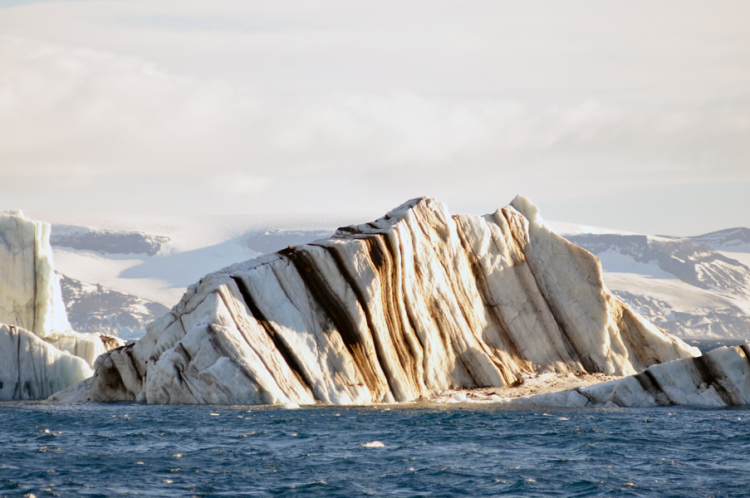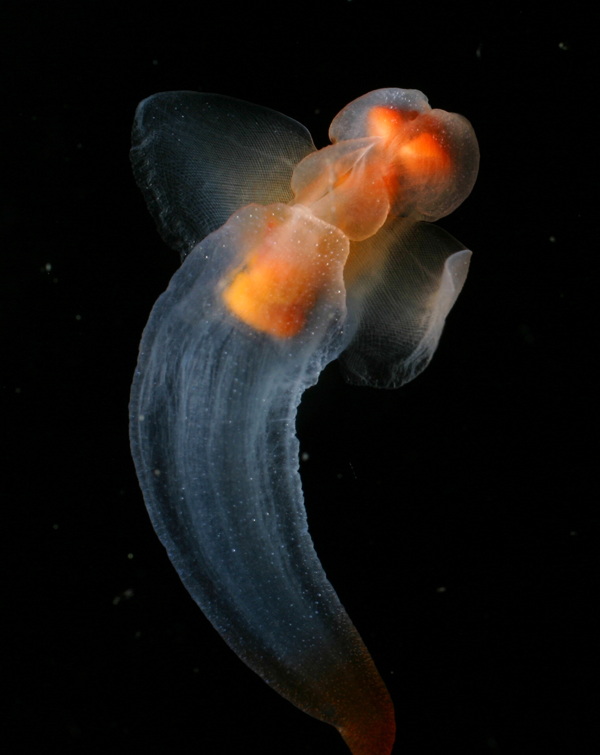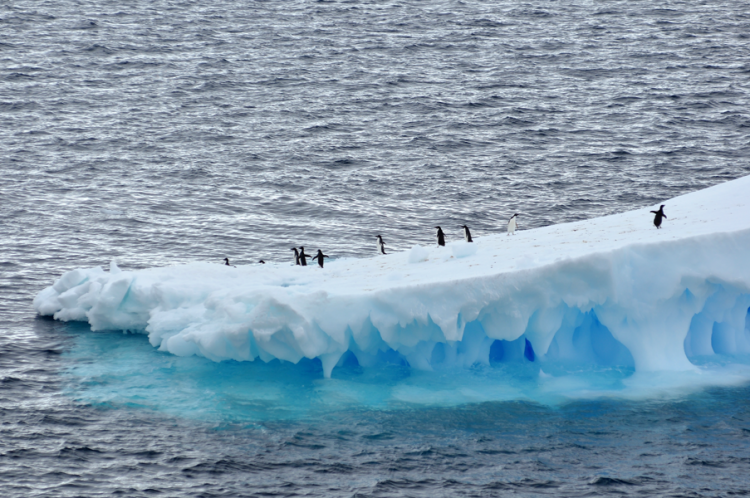To most humans, icebergs play a simple role in the seas: They sink ships. After all, the most famous berg in history gained notoriety by killing 1,500 people when it sent the Titanic to the bottom of the ocean. But as melting poles set more large chunks of ice afloat, icebergs may be in for a reputation overhaul. To scientists studying these frozen barges, they are anything but simple.
As they slowly see-saw and spin through polar currents, icebergs fertilize the oceans. Carrying nutrients from land and sometimes reaching the size of small US states, they drive blooms of life that influence the carbon cycle, as shown in the diagram above. Much more than cold, lifeless killers, they are wandering, dynamic islands — promoting marine life, sucking carbon dioxide from the air and changing as they traverse the seas. The massive and mysterious habitats they create are realms scientists have only just begun to understand.
When ice sets sail
Icebergs are commonly thought of as creatures of the oceans, but in fact they are born on land. They begin as pieces of glaciers — thousands of years of snowfall compacted into mountainous rivers of ice. In slow motion, these rivers flow, churning up and entrapping masses of rock and soil as they grind across the land. A peppering of airborne particles settle on the ice, becoming trapped by new layers of falling snow. These sediments paint the walls of some glaciers (and icebergs) with dark stripes. By the time a chunk of glacier falls into the sea, it is packed with minerals and nutrients from the land — and this enshrined rubble is one way icebergs transform the oceans. As ocean currents carry the berg through its life, it slowly melts, sprinkling iron and other nutrients into the waters around it. These minerals fertilize the tiny photosynthetic plankton that live off sunlight and form the foundation of the marine food web.
"You have this big chunk of iron floating around out there and you get this big intense growth and you can actually see it," says Karen Osborn, a research zoologist at the Smithsonian's National Museum of Natural History who studies how marine invertebrates adapt to challenging environments.

Icebergs come in varied hues and stripes. The patterns record the changing temperatures, rocks, dirt and air particles encountered during their previous lives as glaciers and ice sheets.
CREDIT: MATTIAS CAPE
Satellite images show that the boon to primary productivity brought by an iceberg is surprisingly expansive and can extend as much as 10 times an iceberg's length. A team of UK scientists found that this fertilization could trail more than 600 miles behind the iceberg — with chlorophyll levels in the iceberg's wake spiking as much as 10 times typical levels.
But minerals captured from a life on land explain only part of the burst. The ocean is a stratified system, with horizontal layers forming distinct segments of the ecosystem. Sometimes these layers are as shallow as 60 meters — a bit longer than an Olympic swimming pool. Due to the sheer amount of water they displace as they travel, icebergs can fundamentally disrupt this ocean structure.
"Think about it like a layer cake," says Osborn. "It's much more common to find a certain species of jellyfish in Japan and in California at the same depth versus the same species of jelly at 400 and 2,000 meters in California."
Icebergs, whose enormous underwater bases famously belie their exposed tips, can stretch hundreds of meters deep. During one expedition, Osborn and her colleagues used an unmanned vehicle to follow an iceberg wall deeper than a submerged Seattle Space Needle would reach before the submarine came to the end of its tether. When bergs come crashing through, those nice ocean cake layers are toast. The mixing of the strata, boosted by the iceberg's low-density water melting and rising to the surface, brings massive benefits for microbial life.
An iceberg's wake is invisible, but you can detect it in measures of salinity, oxygen and temperature, says Alison Murray, a marine microbial ecologist at the Desert Research Institute of Nevada, who visits Antarctica every few years for her research. "Most of the time, the bacteria down in the Southern Ocean — I think that they're starving," she says. "When an iceberg goes by it basically stirs up the ocean, and biology likes that, because a lot of the good things lie down below."
A traveling boomtown
Observed by a remotely operated submarine moving down the side of an iceberg, that biology becomes pretty obvious. Algae live in fist-sized grooves that dimple the ice like the face of a golf ball. The algae nestle into the lower ledges of these divots, pointing themselves toward the sun. Other life visits too. Sometimes krill swarm the submarine in hordes so thick "that it blocks the light of a submersible camera," says Osborn. "Other times you'll go minutes without seeing anything."
But the waiting is always well worth it, she says. Witness: sea angels, shell-less relatives of the snail, at their largest roughly the width of a bottle cap, that flap through the water as if they had wings. And strange tomopterid worms, which dance by the ice face, showing off their translucent, fern-shaped bodies.

Bristle worms (genus: Tomopteris), which live at mid-water depths in the ocean, act as both predators and prey in iceberg ecosystems. When attacked, they can emit flashes to confuse approaching predators.
CREDIT: DAVID WROBEL/VISUALS UNLIMITED
Larger life comes around as well. Fish explore caves in the iceberg walls, squawking flocks of petrels and other flying seabirds circle looking for food, and seals and penguins use the floating islands as both shelter and hunting grounds. Occasionally, rare whales have been spotted alongside icebergs, leading scientists to wonder if they too are attracted by the frigid boomtown.
Sending carbon to the depths
All this life generates waste, which is key to the second super power of icebergs: They create a carbon sink. Plankton that harvest energy from sunlight do so with carbon dioxide pulled from the air. The process results in an organic form of carbon, stored in the bodies of the plankton and the animals that eat them. As these life forms die — and when they expel waste —that carbon clumps together and sinks to the ocean floor, where, under certain conditions, it may be stored for thousands of years. And it's not a small amount that gets pulled down.
"Plant life in the ocean is just horrendous," says Ken Smith, an open-ocean ecologist at the Monterey Bay Aquarium Research Institute, referring to the amount of carbon dioxide consumed by the plankton. "One-fourth of the anthropogenic increase in carbon dioxide is absorbed by the ocean, with 30 percent going into plants."
Icebergs may play a role in keeping this number high. University of Sheffield researcher Grant Bigg and his team estimated that as much as 20 percent of the carbon-sink activity in the Southern Ocean is driven by fertilization from giant icebergs. Icebergs, therefore, are a small but important factor in estimating the speed at which our planet is warming, he says.

Clione lamacina, or the sea angel (also called a sea butterfly), is a relative of the snail that grows only to about 30 millimeters (just over an inch) in length. They have been spotted along the hulls of icebergs and likely attract hungry fish and birds.
CREDIT: KEVIN RASKOFF/HIDDEN OCEAN 2005 EXPEDITION: NOAA OFFICE OF OCEAN EXPLORATION
But getting a handle on the exact extent of icebergs' influence on the carbon cycle is no small feat. The equation is complicated by the specifics of each chunk: where it's from, how quickly it escapes to open waters, its size, and how rapidly it melts. In the Arctic, for example, "iron is all over because of the input from rivers, which you don't have in the Antarctic," says Smith. Less is known about the effects of icebergs in the north where iron is more abundant.
And icebergs have a dark side. They gouge sea beds in shallow water, scraping whole stretches of marine life off the ocean floor, including substantial numbers of carbon fixers, which can make it that much harder to figure out icebergs' overall effects on the planet's ocean carbon sinks.
Icebergs up close
More careful, up-close studies of icebergs could build more understanding of their role in the global carbon budget and in ocean life. But that comes with many financial and logistical challenges. Icebergs can get locked in sea ice, making them difficult to reach year-round. Once freed, they move and can be difficult to track. Icebergs can be so large that they have their own waterfalls and airplane-hangar-like caves, and simply approaching them in a vessel can pose dangers. Being too close when a sizable iceberg collapses could have serious consequences.
Mattias Cape, a biological oceanographer at the University of Washington, recalls one Antarctic expedition during which his group was forced to retreat through a narrow stretch between an iceberg and the edge of the continent. Shifting winds had closed their original path and the crew had decided not to wait around to see if the massive iceberg would creep back toward the continent, closing off the remaining escape route.
"You look up and you can't see the top of this iceberg that's tens of meters high. And then you just imagine: If it's 30 meters high, then what's below me?" Cape recalls.

Icebergs serve as shelters and hunting grounds for marine animals such as these Antarctic Adélie penguins.
CREDIT: MATTIAS CAPE
But just as icebergs can be intimidating, they can also be beautiful, Cape says. Far out in the Antarctic, away from friends and family and in a landscape made almost entirely of shades of grays, blues and whites, spotting icebergs provides a pastime. Penguins or seals might leap from their surfaces as a ship approaches. And the icebergs themselves can have "strange combinations that are pretty mesmerizing": a dark blue-black iceberg so transparent that "you could see every one of the little air bubbles within it." Or one with translucent blue streaks alternating across its length like "bands on a zebra." The icebergs are not silent, he says. They creak and crack in the waters, and sometimes they'll suddenly flip, exposing their pocked underbellies.
Even without seeing all the life swirling around below, watching them "is a full sensory experience," he says.




